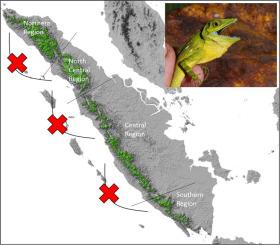当前位置:
X-MOL 学术
›
Mol. Phylogenet. Evol.
›
论文详情
Our official English website, www.x-mol.net, welcomes your
feedback! (Note: you will need to create a separate account there.)
Phylogeography of montane dragons could shed light on the history of forests and diversification processes on Sumatra.
Molecular Phylogenetics and Evolution ( IF 3.6 ) Pub Date : 2020-04-17 , DOI: 10.1016/j.ympev.2020.106840 Kyle J Shaney 1 , Jose Maldonado 2 , Utpal Smart 3 , Panupong Thammachoti 4 , Matthew Fujita 2 , Amir Hamidy 5 , Nia Kurniawan 6 , Michael B Harvey 7 , Eric N Smith 2
Molecular Phylogenetics and Evolution ( IF 3.6 ) Pub Date : 2020-04-17 , DOI: 10.1016/j.ympev.2020.106840 Kyle J Shaney 1 , Jose Maldonado 2 , Utpal Smart 3 , Panupong Thammachoti 4 , Matthew Fujita 2 , Amir Hamidy 5 , Nia Kurniawan 6 , Michael B Harvey 7 , Eric N Smith 2
Affiliation

|
Biogeographical evidence, both, for and against the "regional endemism paradigm" hypothesis has been uncovered across the Greater Sunda Region (Sundaland) of Southeast Asia. Additionally, there are competing hypotheses regarding how Pleistocene forests may have impacted biological patterns and processes in Sumatra. Using montane agamid lizards from Sumatra, we derived and analyzed a phylogenetic dataset, genetic divergence estimates, and contemporary distributional patterns among species. We tested whether (1) Sumatra's highland Draconinae diversification fits the regional endemism paradigm hypothesis and (2) Draconinae phylogeography provides biological evidence for Pleistocene forest extent at various points in history. Our results suggest in situ diversification was the main driver behind montane Draconinae lizard diversification in Sumatra, rejecting the "regional endemism paradigm". Contemporary distribution of endemic species and their genetic relationships may potentially provide biologicalevidence for determining more precise elevational lower limits of montane forests during the Pleistocene epoch. Our data suggests montane forests did not retreat more than 700-750 m during glacial maxima because lower retreating forests would have become interconnected, allowing for widespread dispersal, exchange of gene flow and sympatric distributions contemporarily. To the contrary, our divergence estimates show that cloud forest dragons have been isolated for millions of years, suggesting there may have been a continuous disconnect between some areas, predating the Pleistocene. There may also be other ecological and evolutionary factors that impacted Draconinae distributions, such as competition, making this an excellent system for testing questions regarding montane biogeography. Additionally, we provide the first phylogeny for a wide range of Sundaland agamid species and identify some biogeographic pressures that may have triggered montane Draconinae diversification in Sumatra.
中文翻译:

山地龙的系统记录可能有助于了解苏门答腊的森林历史和多样化进程。
在东南亚的大苏打地区(Sundaland),已经发现了支持和反对“区域特有主义范式”假说的生物地理证据。此外,关于更新世森林如何影响苏门答腊岛的生物模式和过程,存在着一些相互竞争的假设。我们使用苏门答腊的山地蜥蜴蜥蜴,得出并分析了系统发育数据集,遗传差异估计以及物种间的当代分布格局。我们测试了(1)苏门答腊岛的高地龙藻的多样性是否符合区域特有的范例假设,以及(2)龙藻的系统地理学为历史上不同世的更新世森林范围提供了生物学证据。我们的结果表明,就地多样化是苏门答腊山德拉科蜥蜴蜥蜴多样化背后的主要推动力,它拒绝了“区域特有主义范式”。当代特有物种的分布及其遗传关系可能为确定更新世时期山地森林的更精确的海拔下限提供生物学证据。我们的数据表明,在冰川最大时期,山地森林的退缩不会超过700-750 m,因为较低的退缩森林会相互联系,从而允许广泛的散布,基因流量的交换和同胞分布。相反,我们的差异估计表明,云林巨龙已经隔离了数百万年,这表明某些地区之间可能一直存在着不间断的联系,早于更新世。可能还有其他生态和进化因素会影响Draconinae的分布,例如竞争,这使其成为测试有关山地生物地理学问题的出色系统。此外,我们为广泛的Sundaland agamid物种提供了第一个系统发育系统,并确定了可能触发苏门答腊山地Draconinae多样化的一些生物地理压力。
更新日期:2020-04-17
中文翻译:

山地龙的系统记录可能有助于了解苏门答腊的森林历史和多样化进程。
在东南亚的大苏打地区(Sundaland),已经发现了支持和反对“区域特有主义范式”假说的生物地理证据。此外,关于更新世森林如何影响苏门答腊岛的生物模式和过程,存在着一些相互竞争的假设。我们使用苏门答腊的山地蜥蜴蜥蜴,得出并分析了系统发育数据集,遗传差异估计以及物种间的当代分布格局。我们测试了(1)苏门答腊岛的高地龙藻的多样性是否符合区域特有的范例假设,以及(2)龙藻的系统地理学为历史上不同世的更新世森林范围提供了生物学证据。我们的结果表明,就地多样化是苏门答腊山德拉科蜥蜴蜥蜴多样化背后的主要推动力,它拒绝了“区域特有主义范式”。当代特有物种的分布及其遗传关系可能为确定更新世时期山地森林的更精确的海拔下限提供生物学证据。我们的数据表明,在冰川最大时期,山地森林的退缩不会超过700-750 m,因为较低的退缩森林会相互联系,从而允许广泛的散布,基因流量的交换和同胞分布。相反,我们的差异估计表明,云林巨龙已经隔离了数百万年,这表明某些地区之间可能一直存在着不间断的联系,早于更新世。可能还有其他生态和进化因素会影响Draconinae的分布,例如竞争,这使其成为测试有关山地生物地理学问题的出色系统。此外,我们为广泛的Sundaland agamid物种提供了第一个系统发育系统,并确定了可能触发苏门答腊山地Draconinae多样化的一些生物地理压力。











































 京公网安备 11010802027423号
京公网安备 11010802027423号